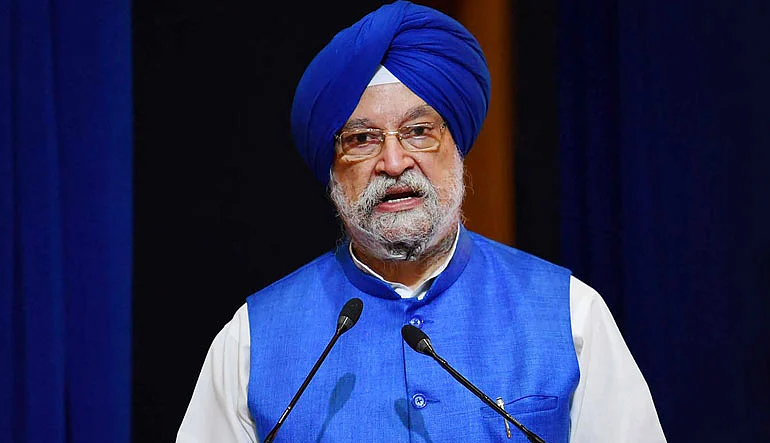Union Minister for Petroleum and Natural Gas Hardeep Singh Puri disclosed that India is close to the Guyana model oilfield in the Andaman Sea. Puri reports that this region has the potential for 184,440 crore litres of crude oil.
He adds that this discovery could transform India from a $3.7 trillion to a $20 trillion economy. This could significantly reduce India's reliance on oil imports and propel economic growth.
India’s exploration for Oil
This discovery comes amid India’s new policy for the increased search and excavation of oil reserves in the country. In this effort, the ministry has increased drilling activity in previously inaccessible areas. This has acted as a major push towards private investment in the indigenous oil sector.
In previous efforts, low-yield oil reserves were found. One of the major efforts made in the oil sector was increasing the oil production in the already high-performing basin of Krishna-Godavari in the last five years.
Puri comments, “When I made this statement about the Krishna Godavari Basin, at that point in time, that was one place. Now we have found green shoots, oil, and several other places. And I think it’s only a matter of time before we find a big Guyana in the Andaman Sea.” He adds that the drilling in the Andaman is ongoing and is expected to be a game changer for the country.
Let’s talk numbers
Currently, India is mainly dependent on imports for crude oil, with 90.6 per cent of our crude oil coming from outside as of May 2025, making us the world's third highest importer of crude oil. This statistic is likely to increase in the coming years with rapid industrialisation and urbanisation.
Puri claims that, if the present estimates are reliable, India could hold 11.6 billion barrels of crude oil, which would be enough to cover all of its energy requirements at home and possibly start shipping fuel. Most importantly, India could surpass the neighbouring countries with a solid economic base in the Asia Pacific region.
As per geological reports, the reserve in the Andaman Sea could yield multi billion barrels of hydrocarbon reserves, particularly oil and gas. However, this reserve is trapped in intricate deepwater sea structures. Meaning that the excavation of this resource could amount to $100 million per well going by the rate in Guyana.
To tackle this expenditure private companies Indian Oil Corporation Ltd. (IOC), Bharat Petroleum Corporation Ltd. (BPCL), Hindustan Petroleum Corporation Ltd. (HPCL), Oil & Natural Gas Corporation Ltd. (ONGC), Oil India Limited (OIL) would require to step up and invest in Andaman.
In a time when tariff war is changing the global market, tapping into a major oil field like the Andaman could help India hold its ground.
What is the Guyana model?
Union Minister Puri while addressing the find in Andaman Sea, drew several comparisons to Guyana.
The small country in South America became the 17th highest oil reserve in the world in recent years. The tiny rainforest state was transformed into a leading petrostate with major oil reserves discovered in 2015 by the American ExxonMobil.
In 2022, Guyana’s GDP grew by 62.3%, the highest real GDP growth in the world that year, according to the International Monetary Fund, as crude oil production boomed. Guyana increased crude oil production by an annual average of 98,000 b/d from 2020 to 2023, now producing more than 800,0000 barrels of crude oil per day.
The discovery of this oil field practically put Guyana on the world map.
Puri believes that the 2 lakh oil reserve in the Andaman Sea could have the same effect for India,. He comments, "Apart from these little discoveries which are coming, which could turn out to be very big also, that we find Guyana — and then you will go from a $3.7 trillion economy to a $20 trillion economy straight away," referring to the discovery of the smaller oil reserves and the game changing Andaman oil reserve discovered.
Environmental Effect
While the oil reserve in the Andaman Sea comes as a major positive for the economy, the impact on the environment of the Andaman island comes as a negative.
Using the same Guyana example Puri used, it can be noted that the rainforest country which primarily attracted outsiders solely for its green canopy and eco- tourism, had to give away its green charm to pursue the more lucrative oil route.
In 2009, the effort to combat global warming turned this into a new kind of currency when Guyana secured $250 million, essentially promising to keep carbon stored in trees. Now, climate change knocks at Guyana’s door as much of its shore is projected to be underwater by 2030 according to Climate Central mapping.
The Andaman Islands stand as a major tourist attraction and host wildlife sanctuaries, marine parks and costing around 179 species of corals. Hence the question arises, ‘what does Andaman stand to lose with the discovery of its oil reserve?’















